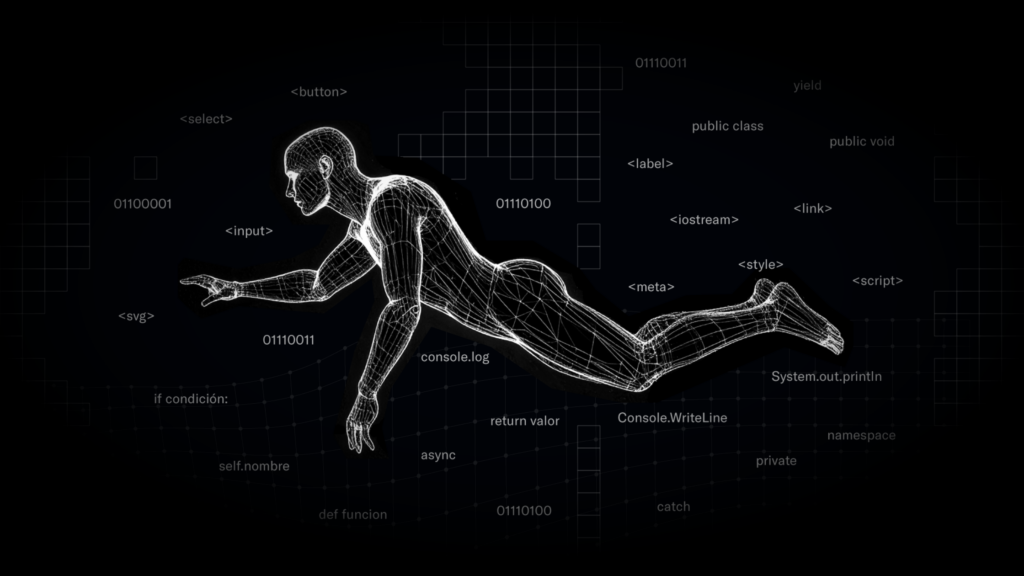Google Cloud Next 2025
April 9th to April 11th 2025
Las Vegas, Nevada
The tech landscape is in constant flux, with new paradigms emerging at a dizzying pace. As a developer, keeping up with these shifts isn’t just about staying relevant; it’s about understanding the foundational changes that will redefine how we build software. The buzz at Google Cloud Next 2025 wasn’t merely about incremental updates; it signaled a profound transformation towards an “Agentic era.” This shift, from writing code to orchestrating intelligent agents, presents both a thrilling opportunity and a critical challenge for developers globally. This article is my personal reflection on the most impactful takeaways from the conference, detailing the emerging trends, the role of natural language in this new ecosystem, and how this will reshape the future of development, especially for a talent solutions agency like Stateside.
Highlights from Google Cloud Next 2025
What struck me most profoundly at Google Cloud Next 2025 was the pervasive theme of “Agents are the new software.” This isn’t just a catchy slogan; it represents a major paradigm shift that will fundamentally alter how software is conceived, written, and deployed. For too long, the barrier to entry for complex software solutions has been traditional coding languages. However, we’re witnessing a significant democratization of software development, where natural language, specifically English, is rapidly becoming the new programming language.
Imagine being able to describe a problem you want to solve, and the tool itself materializes the software solution. This capability, powered by Large Language Models (LLMs), is what truly converts natural language into a powerful programming interface. While current LLMs aren’t always perfectly assertive in their responses, their capabilities are improving at quantum leaps. This progression means that the technical role of the developer will pivot towards architectural oversight, problem definition, and, most importantly, creative potential. The conference strongly emphasized how to leverage technology to unleash the technical team’s creativity.
I had the privilege of attending two presentations by the head of AI at WPP, a marketing agency that has been grappling with AI problems for over 18 years. Perry Nightingale shared fascinating insights, including their internal academy focused on fostering critical and creative thinking to harness AI for content generation. A particularly captivating example was seeing the first advertisement filmed entirely by a robot – a Boston Dynamics robot operating the camera. He argued that using robots for such tasks dramatically boosts productivity, making the demanding physical effort of a 12-hour shift, lifting a 50kg camera, obsolete for humans. This was a delightful “inception of models” at play: an AI model training a physical robot, which then uses another AI model to perform a task. It drove home the message that AI’s power extends far beyond a simple chatbot interface; the sky truly is the limit.

Many Big Names are Already Working on It
It’s clear that this isn’t just Google’s vision; many industry giants are actively participating in this technological revolution. Google has been collaborating for over 18 months with major companies such as Salesforce and SAP to integrate the very innovations showcased at this event into their production environments.
- Salesforce: At their legendary e-commerce demo site, Salesforce has been showcasing new technologies integrated into their platform over the years. They previously had an agent built with Copilot around 18 months ago. This year, they enhanced it using Google’s A2A (Agent-to-Agent) protocol. The result? A fully assisted, hyper-natural shopping experience where a conversational agent guides you from entry to conversion, assisting with purchases, colors, and personalization. It’s so seamless, it feels like talking to a human. This production-ready solution, along with similar integrations by SAP, demonstrates the tangible benefits these industry heavyweights are already reaping from Google’s cutting-edge advancements.
- SAP and FORCE: (As clarified in our previous discussion, “FOR” is not a distinct technology here but likely refers to integrations for enterprise or specific frameworks. The critical takeaway is SAP’s deep partnership with Google Cloud for AI and data.) SAP is leveraging Google’s AI capabilities, particularly with Gemini AI models and Agentspace, for intelligent SAP operations, analytics, and data integration with BigQuery. This highlights a powerful symbiosis where these large enterprises provide data and use cases, and Google provides the advanced AI and cloud infrastructure, driving mutual benefits and accelerating the adoption of agentic technologies.
While Google is releasing numerous documents and examples, some are still in development, acknowledging that OpenAI has gained an early lead in certain areas. Google encourages initial experimentation but advises caution when deploying new tools in production.
Emerging Trends and Technologies
Many companies are now intensely focused on identifying and materializing the best use cases for these emerging technologies. While LLMs gained widespread popularity through everyday assistants like ChatGPT and Gemini – acting as the “gateway drug” for public adoption – enterprises are now exploring deeper monetization strategies, including developing new services, building platforms for custom development, and leveraging their own data through these models.
The ecosystem was quite siloed: if you worked with ChatGPT, you stuck with ChatGPT; with Gemini, then Gemini; with Anthropic, just Anthropic. There was no real standard for inter-model communication. However, a significant development emerged around four months ago: Anthropic released the Model Context Protocol (MCP), positioning it as “the USB” for connecting disparate LLMs and agentic systems. I’ve been experimenting with it, and it’s a truly innovative way to enable interoperability.
The most groundbreaking aspect for development is the ability to connect disparate systems. In traditional development projects, interconnecting various APIs from different companies is notoriously expensive and time-consuming, often taking 18 months with imperfect results. With MCP, you leverage the power of natural language. You can instruct an agent, in plain English, “You will connect to this service provider, who has these tools available, and with these tools, you can perform X, Y, and Z.”
Consider a travel agent AI: “I want to go to Tokyo in 2026, my budget is $15,000, and I’ll be there for 12 days. Please propose an itinerary.” Now, imagine this agent needing to connect to your proprietary APIs for hotel bookings or flight reservations. The MCP helps the AI intelligently parse your request, understand the context, and connect to the right internal tools without explicit programming. While technical effort is still required, the connectivity is vastly simplified.
Anthropic was a pioneer in releasing this tool, and though it’s still in production, Google swiftly entered the race with its own models and protocols. Google’s “secret sauce” for the agentic platform combines:
- LLMs: The foundational language models.
- ADK (Agent Development Kit): Google’s tools for building agents.
- A2A (Agent-to-Agent): Google’s version of inter-agent communication, a “vitamin-enriched” MCP.
- MCP (Model Context Protocol): Indicating Google’s acceptance of open standards.
Google has essentially rolled all this into a comprehensive platform, inviting the world to build and integrate. They’re not just sticking to their own protocols; they’re opening doors for all tools and architectures to integrate with their ecosystem. All of this is incredibly new; six months ago, most of this didn’t exist. This rapid emergence highlights that while Google is a major player, the field is open, with much more to come from other innovators such as Apple and OpenAI.
Using LLMs Power to Interconnect
This agent-driven inter-connectivity is where the true power of this revolution lies. Imagine a system where you can simply ask, “What are today’s closed contracts?” This question, processed through the agentic platform, automatically knows which databases to connect to and where to pull the information. You can even instruct it to present the data in a specific format, like a table, just as you would with ChatGPT, but using your own data and tools.
The crucial takeaway is that natural language is no longer just a query interface; it becomes part of the solution’s architecture itself. It’s built into the core logic, allowing non-technical users to interact with complex interconnected concepts. This is incredibly exciting, as it brings the power of bespoke solutions closer to everyone.
How will this impact Stateside?
This paradigm shift opens up a whole new range of products and services. The concept of agents being agnostic to programming languages (e.g., agents built in Python) signifies immense flexibility. While many are exploring “prompt engineering,” that’s just one layer of a much deeper, evolving landscape. Companies will increasingly need talent to help them develop and manage these agentic solutions, as many aspects will still require technical expertise beyond basic chat interfaces. Many users are still stuck on basic generative AI models, unaware of the advanced tools and platforms now available.
Google is the first to deliver comprehensive products in this space, creating opportunities for enterprises to build their architectures on top of it. This is fascinating because while some concepts are Google-exclusive, the overarching idea of language-agnostic agents is becoming a general industry trend. However, this widespread adoption also raises critical questions, particularly in the realm of security and control. As companies open their systems to agents, ensuring the agents respond appropriately, verify facts (grounding), and maintain brand integrity becomes paramount. This crucial concept of “grounding” – verifying the source and accuracy of AI-generated information – will be a significant challenge for businesses.
We are entering an enormous space of new possibilities that currently lack established solutions or readily available information. This is what truly captivated me.
Questions
“Technology is very powerful, but it doesn’t invent things. It has all the background, but it cannot create. In research, you cannot use it to create knowledge; it is we who have to invent.”
–Yann LeCun
To exemplify this, consider an astronomer. AI cannot autonomously detect new galaxies; it relies on human knowledge and the human ability to create new ideas. As a developer, this understanding gives me peace of mind because it empowers me to seek ways to augment my own potential.
Our People Officer, Monserrat Noguez, highlights that Stateside is perfectly aligned with this future. We are already actively working on several projects utilizing agents to offer “steroid-level” experiences to our clients. We’re rigorously testing these agents as part of our service offering, preparing to launch them soon, as this technology will quickly become a standard, not a differentiator.
The accelerated pace of this technology, making quantum leaps, demands that we find ways to anticipate future needs and capitalize on them. I often caution against getting overwhelmed by the hype. Every day brings a new project or company claiming to have the ultimate solution, only for another to emerge next week, discrediting it. For instance, OpenAI recently released a new image generation model, and two weeks prior, everyone was praising its predecessor, which is now deemed “garbage.” It’s impossible to keep up with every new release. Instead, we must focus on the problems we want to solve and then find the right tool to address them. Monserrat makes an excellent observation: “These companies (Google, OpenAI) are 100% dedicated to this, while companies like ours are focused on delivering other required solutions. In our extra time, we think about how to integrate and refine these.” Indeed, leading tech podcasts suggest that we should dedicate a minimum of 2-3 hours weekly to observing, learning, and becoming experts in AI advancements, developing products around them, and constantly refining them as new iterations emerge.
Conclusion
Overall, Google Cloud Next 2025 sent a clear message to the industry on where it should be moving. As AI becomes more integrated into our day-to-day activities, the developer community must be prepared to create and support the new products and experiences for a new generation of users, who are increasingly aware of technological trends.
For Stateside, being a staff augmentation agency, it’s very motivating and exciting to see all the new possibilities for services we can provide. Why not dream big and see the Stateside logo on the “Partners Slide” at a future Next conference?
This has been a tremendously enriching opportunity to see firsthand what the leaders in the industry are doing and how it’s impacting our world.



